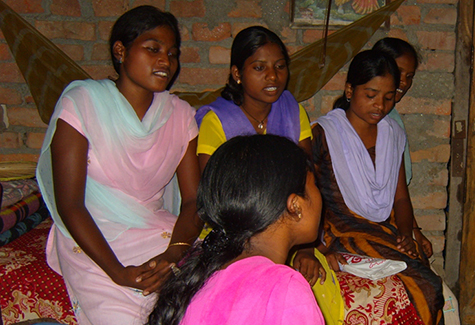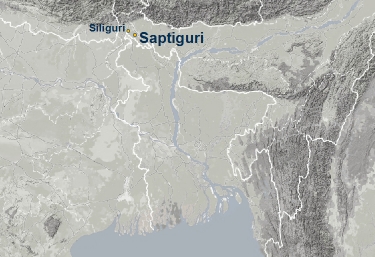Saptiguri, Siliguri, West Bengal. 17 June 2007. Sova Minjh, Deunishia Tirki, Prishka Kindo, Miristilla Tirki and Aruna Panna
In 2003, when we had just about begun to make our field recordings, one of our first trips was to Saptiguri village in Sahabad tea garden in North Bengal, 38 km west of Siliguri town. We went following the beautiful, recorded voice of Nirmala Roy, a singer of bhaoaiya, to listen to her live and make our own recording of her songs. In those early days we were trying to listen to/for expressions and interpretations of biraho (longing for union while being in a state of separation) in the folk music of Bengal. As we travelled, and listened, and as time went by, we began to see that categories such as ‘Bengal’ and ‘folk’ could be both limited and limitless; it all depended on the perspective of the traveller and the listener.
We went back to Nirmala and Chandkishore Roy’s house four years after our first visit, in 2007. Our work was evolving from being an exploration of expressions and interpretations of love, loss and longing in the folk music of Bengal to becoming a shared space of telling and listening. Hence we wanted to share with Nirmala and Chandkishore Roy and their family and friends our recordings of their songs and other recordings from the years in between. We had to tell them about things we had heard, connections we had made, while also ask new questions which had arisen in our minds in the course of our work. And those questions were critical to this return.

Sova, Deunishia, Prishka, Miristilla, and Aruna
North Bengal is a vast expanse of ‘bhaoaiya land’; bhaoaiya is the form, with its sub-regional variations, which is predominantly heard in the foothills of Darjeeling, in Coochbehar and across the Bangladesh border in Rangpur. In the songs of Goalpara in Assam too we hear its traces. Then if we think of the centuries-old history of labour and industry of this region, especially the history of the tea gardens, then we remember that there is more to the region than bhaoaiya. People also sing and talk in many other languages here. There is a history of that sound and a history in that sound. Labourers who had been brought in from western West Bengal, present day state of Jharkhand, Bihar, Orissa and Madhya Pradesh–mainly Oraons or the Mundas—they all had their own songs and dances and rituals, ranging from old harvest songs of ‘karom’ to later church hymns. In 2004, when we had recorded in a tea garden in Srimangal near Sylhet, it felt as though the singers were singing songs from another time and place. As if, following those songlines, we could return with them to an ancestral land whose name even they did not know.
This recording of these five Oraon girls was made in the house of Nirmala and Chandkishore Roy. In fact, when we were discussing the state of the tea gardens, the sickness in the industry, labourers’ songs and so on, then they sent out one of their boys to go and fetch the girls. They all lived in Sahabad tea estate. This really was a preliminary recording we made, a kind of recce, at the end of which we told the girls, that we would go back again, and meet their elders and listen to more songs and stories. Ten years have passed since, and we have not gone back to Saptiguri. And, if we do now, we will probably find things quite changed in the personal lives of the singers. The giggling Sova Minjh and Deunishia Tirki and Prishka Kindo, Miristilla Tirki and Aruna Panna might all be married and with children now, they might no longer live in Sahabad. On the 17 June 2007, they sang because they were asked to sing—they had no preparation and were quite self-conscious in the presence of us outsiders and our microphone, hence nudging each other and trying to hide behind one another. Yet when they began to sing, you could hear how naturally they sang in unison. There is something utterly communal about this singing. And that to us is the beauty of this music.
A song from this session has also been part of an LP on our work, released by Seattle-based Sublime Frequencies, in 2014.
http://www.sublimefrequencies.com/products/576384-the-travelling-archive-folk-music-from-bengal
–Written in June 2017. Revised March 2023
- Saptiguri, North Bengal. 27 November 2003. Nirmala Roy
- Bolpur, Birbhum. 25 November 2003. Nimai Chand Baul
- Kolkata. 4 September 2019. Purnadas on Nabani Das Baul
- Surma News Office, Quaker Street, East London. 27 February 2007. Ahmed Moyez
- Ambikapur, Faridpur, Bangladesh. 29 April 2006. Hajera Bibi
- Sylhet, Bangladesh. 22 April 2006. Chandrabati Roy Barman and Sushoma Das
- Sylhet, Bangladesh. 21 April 2006. Arkum Shah Mazar
- Sylhet, Bangladesh. 20-21 April 2006. Ruhi Thakur and others
- Jahajpur, Purulia. 27 February 2006. Naren Hansda and others
- Faridpur, Bangladesh. 24 January 2006. Binoy Nath
- Uttar Shobharampur, Faridpur, Bangladesh. 22 January 2006. Ibrahim Boyati
- Baotipara, Faridpur, Bangladesh. 21 January 2006. Kusumbala Mondal and others
- Kumar Nodi, Faridpur, Bangladesh. 21 January 2006. Idris Majhi and Sadek Ali
- Debicharan, Rangpur, Bangladesh 18 January 2006 Anurupa Roy & Mini Roy, Shopon Das
- Mahiganj, Rangpur, Bangladesh. 17 January 2006. Biswanath Mahanta & Digen Roy
- Chitarpur, Kotshila, Purulia. 28 November 2005. Musurabala
- Krishnai, Goalpara, Assam. 30 August 2005. Rahima Kolita
- Chandrapur,Cachar. 28 August 2005. Janmashtami
- Silchar, 25 August 2005, Barindra Das
- Kenduli,Birbhum. 14 January 2005. Fulmala Dasi
- Kenduli, Birbhum. 13 January 2005. Ashalata Mandal
- Shaspur, Birbhum. 8 January 2005. Golam Shah and sons Salam and Jamir
- Bhaddi, Purulia. 6 January 2005. Amulya Kumar, Hari Kumar
- Srimangal, Sylhet. 27 December 2004. Tea garden singers
- Sylhet, Bangladesh. 26 December 2004. Abdul Hamid
- Dhaka, Bangladesh. 24 December 2004. Ali Akbar
- Dhaka, Bangladesh. 23 December 2004. Monjila
- Changrabandha, Coochbehar. 16 December 2004. Abhay Roy
- Santiniketan, Birbhum 27 Nov 2004 Debdas Baul, Nandarani
- Tarapith, Birbhum. 14 October 2004. Kanai Das Baul


